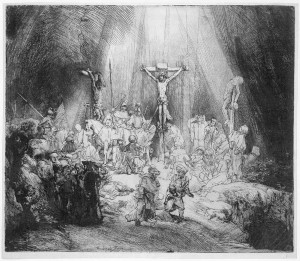 by” is clearly illustrated in this instance. In Italian the two words are virtually identical, both in spelling and pronunciation. They thus involve a play on words. But when translated into other languages, the word-play vanishes. The meaning, on one level, is the same, but on another level it is quite different. Precisely because it is no longer a word-play, the translation doesn’t linger in the mind as much as it does in Italian. There’s always something lost in translation. It’s like saying in French, “don’t eat the fish; it’s poison.” The word ‘fish’ in French is poisson, while the word ‘poison’ is, well, poison. There’s always something lost in translation.
by” is clearly illustrated in this instance. In Italian the two words are virtually identical, both in spelling and pronunciation. They thus involve a play on words. But when translated into other languages, the word-play vanishes. The meaning, on one level, is the same, but on another level it is quite different. Precisely because it is no longer a word-play, the translation doesn’t linger in the mind as much as it does in Italian. There’s always something lost in translation. It’s like saying in French, “don’t eat the fish; it’s poison.” The word ‘fish’ in French is poisson, while the word ‘poison’ is, well, poison. There’s always something lost in translation.
But how much is lost? Here I want to explore five more myths about Bible translation.
Myth 1: The Bible has been translated so many times we can’t possibly get back to the original.
This myth involves a naïve understanding of what Bible translators actually did. It’s as if once they translated the text, they destroyed their exemplar! Sometimes folks think that translators who were following a tradition (such as the KJV and its descendants, the RV, ASV, RSV, NASB, NKJB, NRSV, and ESV) really did not translate at all but just tweaked the English. Or that somehow the manuscripts that the translators used are now lost entirely.
The reality is that we have almost no record of Christians destroying biblical manuscripts throughout the entire history of the Church. And those who translated in a tradition both examined the English and the original tongues. Decent scholars improved on the text as they compared notes and manuscripts. Finally, we still have almost all of the manuscripts that earlier English translators used. And we have many, many more as well. The KJV New Testament, for example, was essentially based on seven Greek manuscripts, dating no earlier than then eleventh century. Today we have about 5800 Greek manuscripts of the New Testament, including those that the KJV translators used. And they date as early as the second century. So, as time goes on, we are actually getting closer to the originals, not farther away.
Myth 2: Words in red indicate the exact words spoken by Jesus of Nazareth.
Scholars have for a long time recognized that the Gospel writers shape their narratives, including the sayings of Jesus. A comparison of the Synoptics reveals this on almost every page. Matthew quotes Jesus differently than Mark does who quotes Jesus differently than Luke does. And John’s Jesus speaks significantly differentyly than the Synoptic Jesus does. Just consider the key theme of Jesus’ ministry in the Synoptics: ‘the kingdom of God’ (or, in Matthew’s rendering, often ‘the kingdom of heaven’). Yet this phrase occurs only twice in John, being replaced usually by ‘eternal life.’ (“Kingdom of God” occurs 53 times in the Gospels, only two of which are in John; “kingdom of heaven” occurs 32 times, all in Matthew. “Eternal life” occurs 8 times in the Synoptics, and more than twice as often in John.) The ancient historians were far more concerned to get the gist of what a speaker said than they were to record his exact words. And if Jesus taught mostly, or even occasionally, in Aramaic, since the Gospels are in Greek the words by definition are not exact.
A useful distinction is made between the very words of Jesus and very voice of Jesus, known as ipsissima verba and ipsissima vox, respectively. Only rarely can we say that we have the very words of Jesus, but we can be far more confident that what is recorded in red letters in translations is at least the very voice of Jesus. Again, if ancient historians were not as concerned to get the words exactly right, we should not put them into a modernist straitjacket in which we expect them to be something they were never intended to be.
Myth 3: Heretics have severely corrupted the text.
This myth is usually promoted by King James Only folks who assume that the manuscripts that came from Egypt were terribly corrupted. A more sophisticated approach seeks to demonstrate this in passage after passage. For example, would orthodox scribes begin the quotation of Isaiah 40.3 and Malachi 3.1 in Mark 1.2 with “As it is written in Isaiah the prophet”? The alternative reading, found in the majority of manuscripts, reads “As it is written in the prophets.” But the earliest, most widespread reading is “in Isaiah the prophet.” It looks as though the later scribes were troubled by this attribution and they ‘corrected’ it to be more generic so as to include Malachi.
What is overlooked in the approach that assumes that the earlier manuscripts were corrupted and produced by heretics is the fact that virtually all Gospels manuscripts harmonize. That is, in parallel passages between two or more Gospels, virtually all manuscripts, from time to time, change the wording in one Gospel so that it duplicates the wording in another. Would heretics do this? It represents rather a high view of scripture—or, as Paul said in another context, zeal that is not according to knowledge. Further, the great majority of these harmonizations are either found in isolated manuscripts or in later manuscripts. This tells us that the tendencies of the earliest scribes was to harmonize, but because such harmonizations are done sporadically and in isolation they are easily detected. And later scribes produced their copies in great quantities in a heavily concentrated area, resulting in a more systematic harmonization—again, something that is easily detected.
This finds an apt analogy in Tolkien’s Lord of the Rings. When the beleaguered hobbits meet the dark stranger, Strider, at the Prancing Pony Inn, they are relieved to learn that he is on their side. He is Aragorn, and he tells them that if he had been their enemy he could have killed them easily.
There was a long silence. At last Frodo spoke with hesitation, “I believed that you were a friend before the letter came,” he said, “or at least I wished to. You have frightened me several times tonight, but never in the way that servants of the Enemy would, or so I imagine. I think one of his spies would—well, seem fairer and feel fouler, if you understand.”
Likewise, the readings of the oldest manuscripts often has a way of making Christians nervous, but in the end it seems fouler but feels fairer.
Myth 4: Orthodox scribes have severely corrupted the text.
This is the opposite of myth #3. It finds its most scholarly affirmation in the writings of Dr. Bart Ehrman, chiefly The Orthodox Corruption of Scripture and Misquoting Jesus. Others have followed in his train, but they have gone far beyond what even he claims. For example, a very popular book among British Muslims (The History of the Qur’anic Text from Revelation to Compilation: a Comparative Study with the Old and New Testaments by M. M. Al-Azami) makes this claim:
The Orthodox Church, being the sect which eventually established supremacy over all the others, stood in fervent opposition to various ideas ([a.k.a.] ‘heresies’) which were in circulation. These included Adoptionism (the notion that Jesus was not God, but a man); Docetism (the opposite view, that he was God and not man); and Separationism (that the divine and human elements of Jesus Christ were two separate beings). In each case this sect, the one that would rise to become the Orthodox Church, deliberately corrupted the Scriptures so as to reflect its own theological visions of Christ, while demolishing that of all rival sects.”
This is a gross misrepresentation of the facts. Even Ehrman admitted in the appendix to Misquoting Jesus, “Essential Christian beliefs are not affected by textual variants in the manuscript tradition of the New Testament.” The extent to which, the reasons for which, and the nature of which the orthodox scribes corrupted the New Testament has been overblown. And the fact that such readings can be detected by comparison with the readings of other ancient manuscripts indicates that the fingerprints of the original text are still to be seen in the extant manuscripts.
Myth 5: The deity of Christ was invented by emperor Constantine.
This myth was heavily promoted in Dan Brown’s Da Vinci Code. He, in turn, based his allegedly true statements (even though the book was a novel, he claimed that it was based on historical facts) on Holy Blood, Holy Grail (by Michael Baigent, Richard Leigh, and Henry Lincoln). The evidence, in fact, that the deity of Christ is to be found in the original New Testament is overwhelming. A look at some of the early papyri shows this. In passage after passage, the deity of Christ shines through the pages of the New Testament—and in manuscripts that significantly predate Constantine. For example, P66, a papyrus from the late second century, says what every other manuscript in John 1.1 says—“In the beginning was the Word, and the Word was with God, and the Word was God.” It predates the Council of Nicea (AD 325), which these skeptics claim is the time when Constantine invented Christ’s divinity, by about 150 years! P46, a papyrus dated to c. AD 200, plainly speaks of Christ’s divinity in Hebrews 1.8. The list could go on and on. Altogether, we have more than fifty Greek New Testament manuscripts that are prior to Constantine’s reign. Not one of them denies the deity of Christ.
To see some of the details that expose these myths, consider the following books:
Rob Bowman and Ed Komoszewski, Putting Jesus in His Place: The Case for the Deity of Christ
Ed Komoszewski, James Sawyer, and Daniel B. Wallace, Reinventing Jesus
Daniel B. Wallace, editor, Revisiting the Corruption of the New Testament.

 “Uno dei malfattori appesi alla croce lo insultava: «Non sei tu il Cristo? Salva te stesso e anche noi!». Ma l’altro lo rimproverava: «Neanche tu hai timore di Dio e sei dannato alla stessa pena? Noi giustamente, perché riceviamo il giusto per le nostre azioni, egli invece non ha fatto nulla di male». E aggiunse: «Gesù, ricordati di me quando entrerai nel tuo regno». Gli rispose: «In verità ti dico, oggi sarai con me nel paradiso»” (Luca 23:39-43).
“Uno dei malfattori appesi alla croce lo insultava: «Non sei tu il Cristo? Salva te stesso e anche noi!». Ma l’altro lo rimproverava: «Neanche tu hai timore di Dio e sei dannato alla stessa pena? Noi giustamente, perché riceviamo il giusto per le nostre azioni, egli invece non ha fatto nulla di male». E aggiunse: «Gesù, ricordati di me quando entrerai nel tuo regno». Gli rispose: «In verità ti dico, oggi sarai con me nel paradiso»” (Luca 23:39-43).